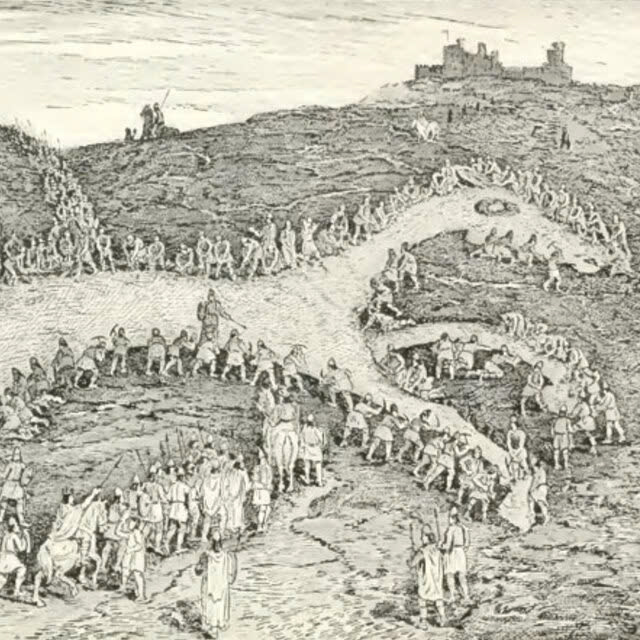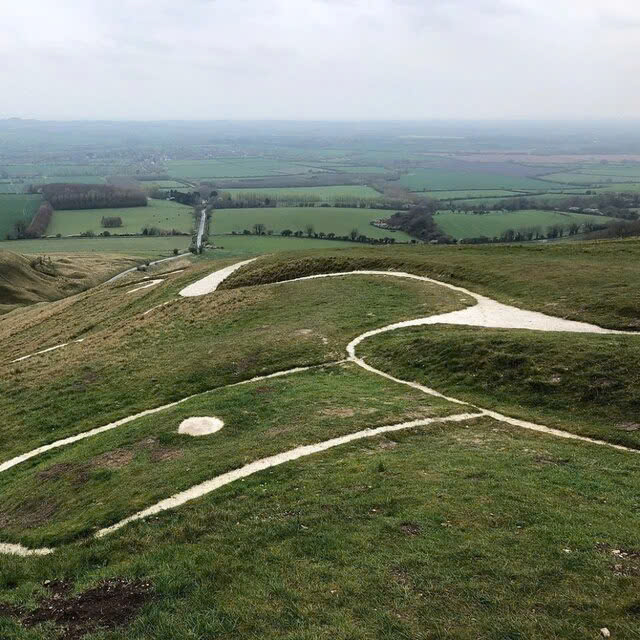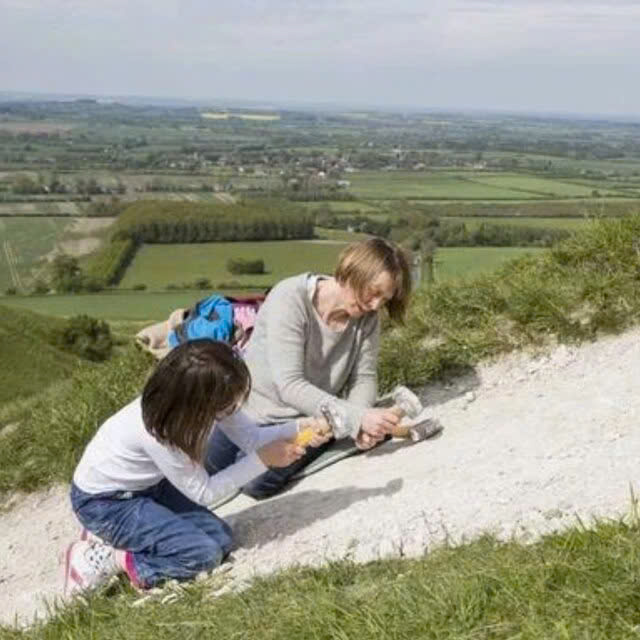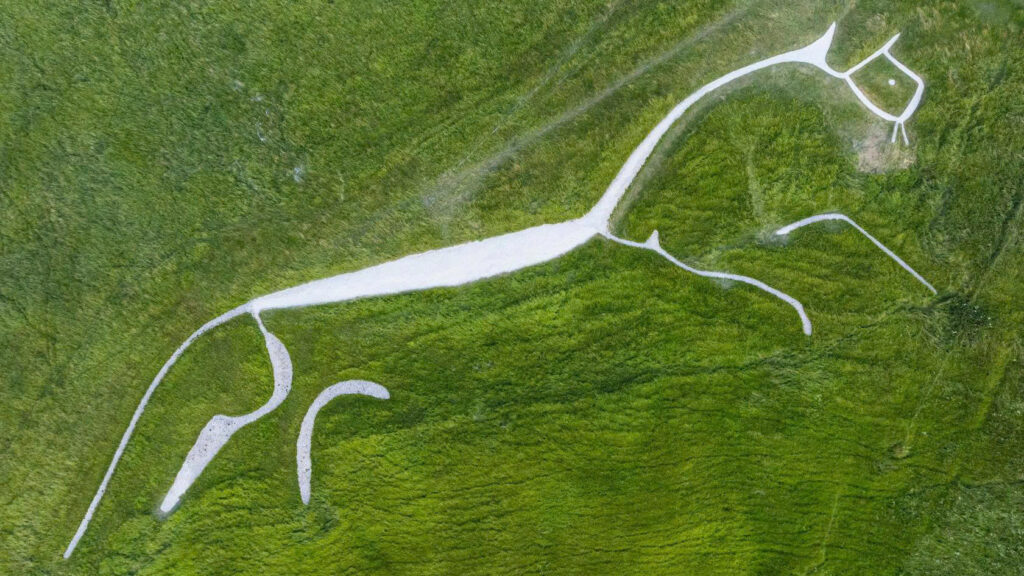Carved into the rolling chalk hills of Oxfordshire stands one of Britain’s most enigmatic ancient monuments. The Uffington White Horse, with its distinctive abstract form and mysterious origins, has watched over the landscape for three millennia, silently guarding its secrets while captivating generations of visitors.
The Bronze Age Marvel That Defied Time

Dating back to approximately 1000 BCE during the late Bronze Age, the Uffington White Horse represents Britain’s oldest known hill figure. This remarkable creation stretches an impressive 110 meters across the hillside, its elegant curves and flowing lines visible for miles around. Unlike more naturalistic horse depictions, the Uffington figure features a distinctively stylized design—an abstract, almost skeletal representation with an elongated body, distinctive beak-like head, and impossibly extended limbs.

What makes this ancient artwork truly remarkable is not just its age but its endurance. Carved into the hillside by removing topsoil to reveal the brilliant white chalk beneath, the horse would have naturally disappeared within decades without human intervention. Yet for three thousand years, countless generations have maintained this extraordinary figure through a tradition known as “scouring”—regularly clearing vegetation and replenishing the chalk to preserve its striking outline against the verdant hills.
Sacred Ground: The Horse and Its Landscape

The White Horse doesn’t stand alone in this ancient landscape. It forms part of a complex of prehistoric features that suggest this area held profound significance to our ancestors:
Uffington Castle and Ancient Power

Crowning the hill above the horse sits Uffington Castle, an impressive Iron Age hillfort surrounded by massive earthen ramparts and defensive ditches. Archaeological excavations have revealed this was once a bustling community center, with evidence of round houses, storage pits, and artifacts that point to a society with sophisticated craftsmanship and trading connections.
The Manger and Dragon Hill: Where Legends Take Root
Below the horse lies a dramatic natural valley called the Manger, its sides rippled with curious undulations known locally as the “Giant’s Steps.” These fascinating formations, created during the last Ice Age by cycles of freezing and thawing, added to the mystical quality of the landscape.

Nearby stands Dragon Hill, a curious flat-topped mound where, according to medieval legend, St. George slew the dragon whose blood left a permanent bare chalk patch where nothing grows. This Christian story likely replaced earlier pagan tales, suggesting the enduring sacred nature of this site across changing belief systems.
Theories and Mysteries: Why Create a Horse on a Hill?
The true purpose behind the Uffington White Horse remains one of Britain’s most enduring archaeological mysteries. Was it a tribal emblem, marking territory for all to see? A religious symbol, perhaps connected to the Celtic horse goddess Epona? Or did it serve more practical purposes, such as a meeting point for communities or a waymarker for travelers?

Some scholars have noted that the horse appears most complete when viewed from above—an impossibility for its Bronze Age creators. This has led to fascinating speculation about ancient understanding of perspective and landscape art, suggesting a sophistication in prehistoric thinking that challenges our assumptions about early societies.
Modern archaeological techniques have revealed that the current horse may actually be a refined version of an earlier, larger figure. Over centuries, soil movement and repeated recutting subtly altered its shape—the horse we see today carries the imprint of countless hands across millennia, each generation adding their mark to this communal masterpiece.
The Scouring Tradition: A Community United Across Time
For centuries, cleaning and maintaining the White Horse evolved into festive community gatherings. Historical records describe the “Scouring of the White Horse” celebrations dating back to at least the 1700s, with thousands gathering for sports competitions, feasting, and music before collectively restoring the chalk figure to brilliant whiteness.
After a period of decline, these traditions have been revitalized in modern times. Today, the National Trust organizes regular “chalking days” where volunteers armed with hammers and buckets of chalk participate in maintaining this ancient monument, creating a direct connection between modern participants and their Bronze Age ancestors.
A Hidden Horse: Wartime Camouflage

During World War II, the horse faced an unusual threat—its distinctive outline, visible from high above, could potentially guide enemy aircraft. Military authorities made the extraordinary decision to temporarily camouflage this ancient landmark, covering it with turf and brush to hide it from aerial view. After the war ended, archaeologists carefully restored the figure, bringing it back to life after its brief wartime slumber.
Experiencing the Wonder Today
Modern visitors to the White Horse can explore this ancient landscape via well-marked trails that connect the horse with nearby prehistoric sites. The National Trust maintains a circular walking route that offers stunning panoramic views across multiple counties on clear days.

The experience of standing beside this ancient monument creates a powerful connection to the past. One visitor recently described it as “standing in the footprints of ancestors who walked here three thousand years ago—you can almost feel their presence in the wind that sweeps across the hills.”
Video
A Living Symbol in Modern Culture
The Uffington White Horse has transcended its mysterious origins to become a powerful cultural symbol. It has inspired literature, including Thomas Hughes’ 1859 novel chronicling the scouring festivals. Its distinctive shape appears in modern art, jewelry, tattoos, and even corporate logos.

For local communities, the horse represents continuity and identity—a tangible link to ancestors who shaped the same landscape millennia earlier. For visitors from around the world, it offers a glimpse into prehistoric Britain and a reminder of humanity’s enduring creative spirit.
Preserving the Legacy for Future Generations
As climate change and increasing tourism pose new challenges to ancient monuments, conservation efforts have intensified. The National Trust employs modern scientific techniques alongside traditional maintenance methods to monitor erosion, protect the chalk surface, and manage visitor impact.

These efforts ensure that the Uffington White Horse will continue to race across its hillside for generations to come—an enduring bridge between our modern world and the mysterious people who first carved this magnificent creature into the rolling Oxfordshire landscape three thousand years ago.
Whether you view it as an archaeological treasure, an artistic masterpiece, or a spiritual landmark, the Uffington White Horse stands as a testament to human creativity and our deep connection to the landscapes that shape our cultures and imaginations.

